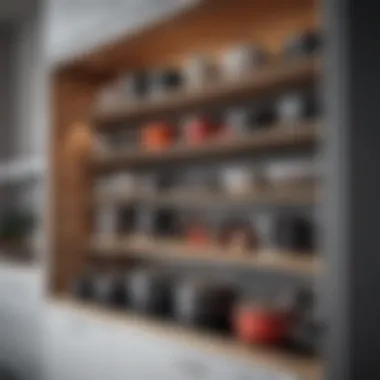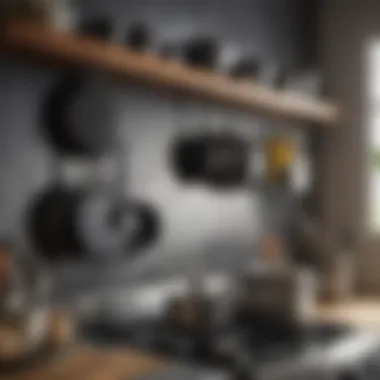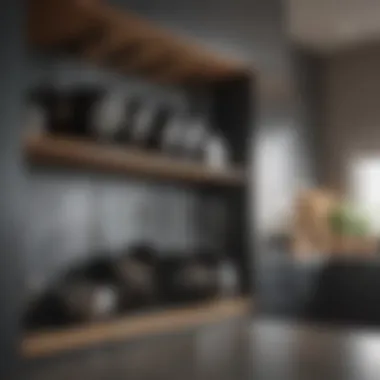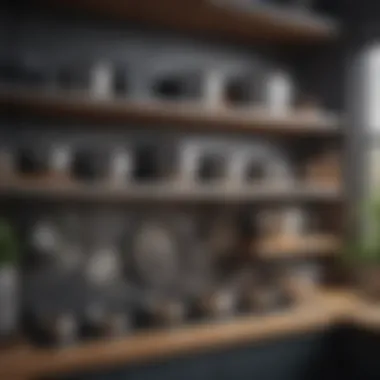Mastering Cookware Storage: Innovative Strategies


Intro
Effective cookware storage is essential for maximizing kitchen functionality. In most kitchens, the arrangement and accessibility of cookware can significantly impact cooking efficiency. This article delves into various strategies and solutions for organizing cookware, ensuring easy access, maintaining proper condition, and even considering aesthetic aspects.
A well-structured storage solution boosts not only convenience but also the longevity of cookware. Dishes and pots need protection from scratches and damage. By implementing the right techniques, homeowners can create a functional kitchen space that reflects personal style and improves workflow.
In the upcoming sections, we will explore current trends in interior design related to kitchen organization, practical tips for effective storage solutions, and how to keep your cookware in optimal condition. With these insights, readers will gain valuable knowledge to transform their kitchen's storage capabilities.
Intro to Cookware Storage
Cookware storage is a critical aspect of kitchen management that often goes unnoticed. Proper storage solutions can greatly improve the functionality and efficiency of a kitchen. When cookware is organized well, it enhances not just accessibility but also safeguards the condition of the items. Effective storage can lead to a more productive and enjoyable cooking experience. This section will explore the significance of cookware storage and how it influences overall kitchen organization.
Understanding the Importance of Cookware Storage
The way cookware is stored directly affects its longevity and usability. Without a well-planned system, pots and pans can become damaged. Scratches and dents can occur when items are stacked improperly. Moreover, when a cook cannot easily locate the right pot or pan, it can lead to frustration. Therefore, it is vital to assess personal storage needs and adopt strategies that protect cookware while making it readily accessible.
Benefits of Effective Cookware Storage:
- Prevention of Damage: Avoid scratches and dents by using proper storage techniques.
- Accessibility: Quick access to items speeds up meal preparation.
- Organization: A tidy kitchen creates a more enjoyable cooking environment.
The Impact of Effective Storage on Kitchen Organization
Effective cookware storage has a profound impact on kitchen organization. When cookware is stored correctly, it ensures that every item has its designated place. This not only saves time when cooking but also enhances the aesthetic appeal of the kitchen.
Positive Outcomes of Organized Cookware:
- Efficiency: Streamlined access decreases cooking times.
- Enhanced Design: Organized cookware contributes to a visually appealing kitchen.
- Reduced Stress: A systematized kitchen lessens the chaos often experienced during meal prep.
"An organized kitchen is not just a nicer space to cook in; it supports better cooking practices and creates a sense of calm."
In summary, the importance of cookware storage is multifaceted. It makes a measurable difference in the functionality of the kitchen space. Understanding how to maximize cookware storage will ultimately lead to a better cooking experience, encouraging greater enjoyment and creativity.
Types of Cookware and Their Storage Requirements
Understanding the types of cookware and their specific storage requirements is crucial for maintaining an organized and functional kitchen. Each cookware category has different properties, which affect how it should be stored to ensure longevity and usability. Proper storage can prevent damage, promote efficiency, and simplify the cooking process. This section will delve into the common types of cookware materials and their respective storage needs.
Analyzing Common Cookware Materials
Cookware comes in various materials, each presenting its advantages and disadvantages. Here are some common types:
- Stainless Steel: Durable and non-reactive, stainless steel pans are popular for their versatility. They should be stored in a way that avoids scratching. Nesting them can work, but using padded dividers is ideal to prevent damage.
- Cast Iron: Known for its heat retention, cast iron cookware needs special treatment. After each use, it should be cleaned but not soaked. Storing it in a dry area is essential to prevent rust. It’s advisable to place a paper towel between stacked pieces to absorb moisture.
- Non-Stick: This material makes cooking and cleanup easy. It's vital to use silicone or wooden utensils to maintain the coating's integrity. Non-stick pans should be stored individually to avoid scratching; a dedicated space is recommended.
- Copper: Copper offers excellent conductivity but tarnishes easily. To store copper cookware, use a cloth wrap to avoid contact with other metals, which can cause scratches and damage.
- Ceramic: Although ceramic cookware is attractive, it can chip easily. Using a cushioned organizer or separating dividers can maintain their aesthetics and functionality.
This analysis helps homeowners and cooking enthusiasts understand the best ways to care for and store their collection effectively.
Understanding Specific Storage Needs of Different Cookware
Different cookware types require specific storage strategies to ensure that they remain in good condition and are ready for use. Consider these points:
- Hanging Racks: Ideal for pots and pans, a hanging rack maximizes vertical space. It's also visually appealing, showcasing your cookware collection.
- Drawer Organizers: These can be great for storing utensils and smaller items. Drawer dividers help keep things neat and prevent damage to delicate pieces like non-stick skillets.
- Cabinet Arrangement: Arranging pots and pans by size and frequency of use within cabinets enhances accessibility. Use pull-out shelves or risers to maximize space, allowing for easier access to all items without stacking.
- Shelf Stacking: For items that can stack, ensure heavier cookware goes on the bottom shelf. Always place lighter items on top to avoid crushing delicate cookware.
- Temperature Control: Ensure that storage spaces are not exposed to extreme temperatures or humidity. This is especially crucial for wooden handles and coatings of non-stick and ceramic cookware.
Incorporating these specific storage needs can lead to a more functional kitchen and prolong the lifespan of cookware.


"A well-organized kitchen is not only a joy to cook in but also enhances the overall aesthetic of your home."
By understanding the nature of several materials and how best to store them, one can maintain both functionality and appearance in the kitchen. This foundational knowledge equips homeowners and design aficionados with the insights needed to create an organized and beautiful cooking space.
Assessing Your Kitchen Space for Cookware Storage
Assessing your kitchen space is a crucial step when it comes to effective cookware storage. Understanding the unique layout and design elements of your kitchen can significantly influence how you choose to organize your cookware. This section provides insight into evaluating kitchen layouts and identifying available storage areas, which will help optimize your storage solutions.
Evaluating Kitchen Layouts and Design
Every kitchen has its own layout, whether it's galley, L-shaped, or U-shaped. Recognizing the strengths and weaknesses of your kitchen design is essential. A galley kitchen, known for its narrow layout, may benefit from vertical storage solutions, as its limited floor space can constrain movement. On the other hand, a U-shaped kitchen allows for a variety of storage options, including cabinets, drawers, and shelves that can accommodate various sizes of cookware.
Here are some considerations to think about:
- Flow of Movement: Assess how frequently you cook. If you are an avid cook, ensuring your cookware is easily accessible will save significant time in meal preparation.
- Proximity to Cooking Areas: Store cookware close to the cooking area. If your stove and oven are on one side, keep pots and pans within arm's reach.
- Counter Space Availability: More counter space provides an excellent opportunity for a set of frequently used cookware to be more accessible. Also, think about how much space you can dedicate to storage solutions.
Understanding these design elements can lead to smarter storage decisions.
Identifying Available Storage Areas
Once you evaluate your kitchen layout, the next step is identifying potential storage areas. This can include various underutilized spaces. Here are some areas to look at:
- Cabinets and Drawers: Assess the depth and height of cabinets. Use shelves or dividers in deeper cabinets to maximize space.
- Under-Sink Space: This area is often disregarded but can be transformed with proper organizers. Consider stackable bins or thin shelves.
- Wall Space: Look for walls that could fit floating shelves or racks. This can create a home for frequently used pots.
- Above the Refrigerator: This spot is generally overlooked but can hold less-used items. Use this space wisely but ensure accessibility.
The goal is to fully utilize every nook and cranny of your kitchen to store your cookware effectively.
Assessing these elements of your kitchen space will provide a strong foundation for organizing cookware storage efficiently and effectively.
Innovative Cookware Storage Solutions
Innovative cookware storage solutions are essential for maintaining a well-organized kitchen environment. The effectiveness of storage not only improves accessibility but also prolongs the life of cookware. In this section, we will explore several methods that can transform cluttered spaces into efficient storage areas. These solutions will consider various kitchen designs and the specific needs of different cookware types.
Utilizing Cabinet Space for Optimal Storage
Cabinets are often the most underutilized storage areas in any kitchen. By maximizing the potential of cabinet space, homeowners can create organized zones for their cookware. Installing adjustable shelves allows for flexibility in height, accommodating different sizes of pots and pans. Additionally, incorporating pull-out shelves or lazy Susans can enhance accessibility, making it easier to retrieve items without the usual hassle of digging through stacked cookware.
A few practical tips for optimizing cabinet space include:
- Categorizing cookware by type—group pots with pots and pans with pans.
- Using tiered organizers for lids which saves space and improves visibility.
- Installing hooks on the inside of cabinet doors to hold utensils or pot lids.
Incorporating Drawer Organizers and Dividers
Drawers offer a fantastic opportunity for customized cookware storage. By using drawer organizers and dividers, one can keep utensils and smaller items neatly stored away. These tools create specific compartments allowing for effortless access to various cooking tools. It is advisable to opt for organizers that can be adjusted to fit the user's cookware dimensions, accommodating changes in the collection.
Benefits of using drawer organizers:
- Enhanced organization that minimizes chaos during meal preparation.
- Reduced wear and tear on cookware by preventing clanging or scratching with properly separated items.
- Maximized space since deeper drawers can hold heavier cookware without the risk of tipping.
Employing Vertical Space with Shelving Units
Vertical space is often overlooked in kitchens. Utilizing shelving units is a smart way to take advantage of height and store cookware effectively. Tall shelving can be used for less frequently used items while keeping everyday cookware within reach.


When designing shelf layouts, consider the following:
- Open shelves for easy access to frequently used pots and skillets.
- Closed shelves for storing specialized items that are not used daily, protecting them from dust and damage.
- Labeling shelves to indicate contents, streamlining the retrieval process.
Installing Hanging Racks and Pegboards
Hanging racks and pegboards are versatile storage solutions that enhance both functionality and aesthetics in a kitchen. They can be installed on walls to keep cookware visible and accessible. This approach not only saves space but also adds a unique design element to kitchen interiors.
To capitalize on this strategy, consider these points:
- Heavy-duty hooks to secure larger cookware such as skillets and Dutch ovens.
- Adjustable pegboards which can be customized according to individual needs, easily adapting to the evolving cookware collection.
- Integrating spice racks or utensil holders on the same wall area, creating a multifaceted storage solution.
Properly designed storage solutions not only enhance kitchen efficiency but also contribute to an aesthetically pleasing cooking environment.
These innovative storage solutions are crucial for anyone looking to improve their cookware organization. By making strategic choices about how cookware is stored, one can simplify cooking tasks while safeguarding the longevity of essential kitchen tools.
Maintaining Cookware Condition during Storage
Maintaining the condition of cookware during storage is an often overlooked aspect of kitchen management. When cookware is stored improperly, it can lead to scratches, stains, and deterioration, reducing the items' usability over time. This section will explore crucial practices to ensure that cookware remains in optimal condition, preserving both functionality and aesthetics.
Proper Cleaning and Drying Techniques
Cleaning cookware before storage is essential to prevent food residue from causing unwanted damage. Here are important techniques to consider:
- Thorough Cleaning: Before putting cookware away, it must be thoroughly cleaned. For stainless steel or non-stick pans, use mild detergents that do not scratch surfaces. Avoid harsh chemicals, which can corrode materials over time.
- Drying Completely: After washing, drying cookware completely is vital. Residual moisture promotes rust and mold, especially in cast iron and stainless steel. Use a soft towel or allow pieces to air dry. Always ensure that lids, if used, are also dried properly.
- Storing in a Dry Place: Ensure your storage area is dry. Humidity can encourage oxidation in metal types and deterioration in non-stick coatings.
These steps not only help maintain the cookware’s appearance but also extend its functional lifespan.
Using Protective Linings and Covers
To safeguard cookware from potential damage during storage, using protective linings and covers is crucial. Here are effective methods:
- Using Liners: Placing soft cloths or paper towels between stacked cookware prevents scratching. This is particularly useful for nesting pots and pans.
- Covering Cookware: Utilizing pot lids or investing in dedicated cookware covers protects pots from dust and other environmental factors. Covers help prevent scratches and denote that the cookware is in storage rather than in use.
- Bamboo or Cork Mats: For higher-end cookware, these materials can serve as protective barriers. They absorb excess moisture and provide a cushion against scratches.
- Labels and Binders: For organizing sets, consider labeling each piece within their protective covers. This helps maintain order and easy access.
Using protective measures not only enhances the longevity of cookware but also simplifies the organization and retrieval process when it is time to cook.
Aesthetic Considerations in Cookware Storage
Cookware storage is not solely about practicality and organization. The aesthetics of storing cookware can significantly influence the overall look and feel of a kitchen. When cookware aligns with the kitchen's decor, it transforms not just a functional space but enhances the ambiance. This consideration helps in creating a cohesive environment where every element, including pots, pans, and accessories, feels integrated with the kitchen's design.
A well-thought-out cookware storage solution can bring order to the chaos of kitchen clutter. Here, beauty meets functionality, allowing for a more enjoyable cooking experience. Selecting materials, colors, and placement becomes vital as these choices contribute not only to usability but also to visual appeal. There are several key elements to ponder:
- Color Coordination: Aligning cookware colors with the kitchen palette fosters a unified look. Brightly colored pots can add vibrancy to a minimalist space, while muted tones may complement a modern aesthetic.
- Materials and Textures: Utilizing cookware made from materials like polished stainless steel or cast iron can enhance the kitchen's texture. Their organic appearance can bring warmth or elegance to various styles.
- Visibility of Cookware: Open shelving provides the opportunity to showcase cookware as part of the decor while remaining practical for daily use. However, it is also essential to maintain cleanliness and arrange items neatly.
- Harmonious Composition: Creating a pleasing arrangement of cookware can be visually pleasing. Consider varying sizes of pots and pans to create visual interest without overcrowding the space.
"A kitchen's aesthetics can greatly affect one's time spent cooking and entertaining. Good storage practices respond to both organizational and visual needs."
Harmonizing Cookware with Kitchen Decor
When harmonizing cookware with kitchen decor, one must consider how each piece interacts with existing elements. Cohesion is key; thus, it's beneficial to assess color schemes, styles, and materials in your kitchen. For instance, when using a country-style kitchen, wooden storage solutions paired with rustic cookware can emphasize that design ethos.
For modern kitchens, sleek lines and stainless-steel finishes can underline a contemporary feel. Additionally, the placement of cookware communicates intent. Using hooks for hanging pots can become a feature while still keeping them accessible.


- Evaluate color and pattern: Opt for cookware that echoes the kitchen's primary and accent hues.
- Choose furniture and storage that feels in sync with cookware style. This includes cabinets, shelves, and racks.
Choosing Storage Solutions that Enhance Visual Appeal
Choosing storage solutions that elevate visual appeal means looking beyond functionality. The ideal solution enhances both space and aesthetics. For example, using decorative baskets for lids and utensils maintains an orderly look while adding texture.
- Glass Cabinets: These allow for visibility of the cookware without compromising on cleanliness. They can be a stylish centerpiece in your kitchen.
- Open Shelving: Practical yet ornamental, open shelving can be used to showcase high-quality cookware, transforming simple items into art.
- Decorative Containers: Using stylish containers for measuring tools and other small utensils can integrate these items into the decor instead of letting them clutter counters.
Evaluating Cost-Effective Storage Options
In the realm of cookware storage, the balance between quality and affordability is a significant consideration. Homeowners are keen on finding solutions that do not compromise the integrity of their cookware while still adhering to budget constraints. Understanding how to evaluate cost-effective storage options will empower you to make informed decisions that enhance not only the organization of your kitchen but also your overall cooking experience. The importance of this assessment lies in two primary factors: financial impact and functionality.
A sensible approach to evaluating storage solutions starts with prioritizing essential needs. Focus on the type of cookware you frequently use. For instance, if you have a collection of non-stick frying pans, investing in a dedicated pan organizer may be more beneficial than purchasing a generic shelving unit that provides no specific support for those pans. It is crucial to match the storage method with the particular needs of your cookware.
"A well-organized kitchen not only saves time but also enhances the joy of cooking."
By carefully assessing what you require, you can avoid unnecessary expenses while securing the tools essential for an efficient kitchen.
Balancing Quality and Affordability
Quality should never be sidelined in the search for affordable options. It is tempting to choose the cheapest storage solutions on the market. However, inferior products may lead to damaged cookware or inefficient space usage. A well-made pot rack or a sturdy cabinet organizer may cost more initially, but they are investments worth making. They offer longevity, preventing replacement costs down the road. Look for products that are made from durable materials, such as stainless steel or high-grade plastic. These materials not only last longer but also maintain their appearance and functionality over time.
When shopping for cookware storage, consider the following elements:
- Reviews and Ratings: Check customer feedback online before making purchases.
- Materials Used: Choose items designed with quality in mind.
- Warranty Information: A product with a warranty often indicates confidence in its quality.
The goal is to strike a harmonious balance between cost and quality, ensuring satisfaction with your storage solution in the long term.
DIY Solutions for Custom Cookware Storage
Creating your own storage solutions can also be an excellent way to save money while providing customized options that perfectly fit your kitchen’s requirements. DIY projects can vary from simple to complex, depending on your skill level and the tools available.
For those inclined toward craft projects, here are some cost-effective ideas:
- Magnetic Strips: Attach magnetic strips to walls or inside cabinets to hold metal pans and lids securely.
- Wooden Crates: Use untreated wooden crates to create a rustic shelving unit for larger pots and pans.
- PVC Pipes: Cut PVC pipes to size and stack them vertically to store lids or utensils.
These solutions serve to maximize space while allowing a personal touch to your kitchen aesthetics. Engaging in DIY projects can also foster greater satisfaction with your kitchen setup and promote a connection to the space you work in.
Evaluating cost-effective storage options ultimately allows for careful consideration of choices, ensuring your cookware remains organized, accessible, and in excellent condition for years to come.
Epilogue
Cookware storage is a crucial aspect of a functional kitchen. It not only affects the organization of space but also influences the longevity of cookware. Effective storage can lead to ease of access, which is essential for culinary enthusiasts and casual cooks alike.
Summarizing Key Points on Cookware Storage
In this article, several key points were emphasized regarding cookware storage:
- Understanding Various Cookware Types: Different materials such as stainless steel, cast iron, and non-stick require tailored storage methods. Knowing this can prevent damage and extend their lifespan.
- Assessing Kitchen Space: The kitchen layout plays a significant role in determining optimal storage solutions. Identifying available space is essential for effective organization.
- Innovative Solutions: Utilizing vertical space with shelving units and drawer organizers was highlighted as a practical method to maximize storage.
- Maintenance Practices: Proper cleaning and drying techniques are critical in maintaining cookware condition during storage.
- Personalization of Solutions: Storage should reflect individual cooking habits and kitchen aesthetics to enhance both functionality and visual appeal.
Overall, integrating these strategies can significantly improve kitchen efficiency.
Encouraging a Personalized Approach to Storage Solutions
Every kitchen is unique, and so are the needs of its users. It is important for individuals to assess their cooking styles and preferences when deciding on cookware storage solutions. One person might find value in wall-mounted racks for easy access, while another may prefer concealed storage within cabinets to maintain a clean look.
Considering elements like:
- User habits: Do you often cook large meals? This could necessitate more accessible storage for frequently used cookware.
- Kitchen aesthetics: Choose storage solutions that complement the overall decor of your kitchen. This could include stylish organizers or racks that align with your design goals.
- Space constraints: Tailoring your storage to fit the size and layout of your kitchen is essential. There are numerous compact designs available which offer efficient storage without sacrificing style.



